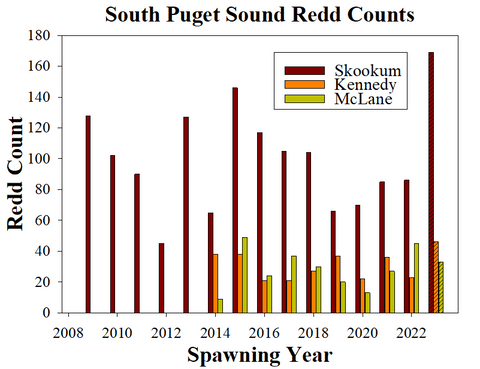
Coastal cutthroat trout (Oncorhynchus clarkii clarkii) are elusive and enigmatic residents of the Pacific Northwest and, quite frankly, our favorite species to target on the fly. While salmon and steelhead often take the spotlight, this remarkable trout species play a vital role in the region's freshwater ecosystems. However, until recently our understanding of their abundance and spawning behavior has been limited. In this in-depth blog, we delve into the fascinating world of Coastal Cutthroat Trout and shed light on the groundbreaking efforts of the Coastal Cutthroat Coalition (CCC) and the Washington Department of Fish and Wildlife (WDFW) to monitor their populations using redd surveys.
To assess the abundance and spawning timing of salmon and steelhead populations worldwide, spawning ground surveyors count spawning nests, known as redds, along streams and rivers. Redd surveys offer a cost-effective method to monitor population trends over time, but they rely on trained surveyors consistently covering the same stretch of water for multiple years. While redd surveys have been conducted for salmon and steelhead, similar efforts for cutthroat trout have been scarce until recently.

According to James Losee, the Regional Program Manager of the WDFW, spawning ground surveys for cutthroat trout have only gained attention in recent years. The identification of redds and spawn timing has been a crucial step in understanding the reproductive habits of these trout species. Scientific papers are available on the Coastal Cutthroat Coalition webpage that we will link below!
Since 2006, redd surveys in South Puget Sound led by the WDFW and the CCC have provided the only estimates of Coastal Cutthroat Trout abundance in this region. By diligently counting redds in specific survey areas, scientists and volunteers have gathered valuable data on the populations' dynamics. This collaborative effort has helped shed light on the status of Coastal Cutthroat Trout and has contributed to a better understanding of their conservation needs.
Recent surveys conducted by trained surveyors have yielded promising results. In comparison to previous years, this year's counts have revealed a higher number of redds in the survey areas, indicating a potential increase in Coastal Cutthroat Trout abundance. While this is undoubtedly encouraging, it is essential to exercise caution when interpreting these trends, as there is no historically abundant information available prior to 2006.


The Need for Expanded Redd Surveys:
To gain a comprehensive understanding of Coastal Cutthroat Trout populations, it is crucial to expand redd surveys to other areas across their range. This includes regions along the California, Oregon, Washington coasts, British Columbia, and Alaska. By initiating redd surveys in these areas, we can obtain a clearer picture of the status and health of these populations. The sooner these surveys begin, the sooner we can take informed conservation actions based on the data collected.
Coastal Cutthroat Trout are captivating inhabitants of the Pacific Northwest's freshwater ecosystems, and their conservation is of paramount importance. Through the partnership between the CCC and the WDFW, redd surveys have provided a unique and cost-effective means to monitor the abundance and spawning times of these trout species. As redd surveys expand across their range, our understanding of Coastal Cutthroat Trout populations will deepen, enabling us to make informed conservation decisions to safeguard their future.
By investing in continued research, collaborative partnerships and increased redd surveys, we can ensure the long-term conservation and appreciation of Coastal Cutthroat Trout, benefiting both these remarkable fish and the ecosystems they call home.
All Charts and Graphs are pulled directly from the Coastal Cutthroat Coalition. Thank you so much to James Losee, The Coastal Cutthroat Coalition and WDFW for all that they do: https://coastalcutthroatcoalition.com/
Leave a comment